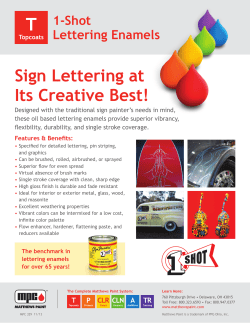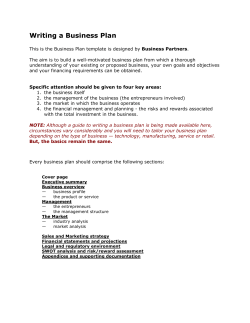
Aircraft Drawing and Blueprint Reading
Aircraft Drawing and Blueprint Reading Course Introduction • Types of drawings – Engineering – also known as production or working drawings. – Block diagram Types of Drawings – Schematics – Sketches – Charts and graphs Production Drawings • Detail • Assembly • Installation Detail Drawing • Consists of one part or several parts of an assembly. • Contains all the specs needed to make the part. Assembly Drawing • Shows how parts from detail drawings are assembled to form a component. • Does not show dimensions except those necessary for location purposes. Cut-Away View Assembly Drawing Exploded View Installation Drawing • Shows how a part or component is installed in the aircraft. • Location and directional dimensions are included. Block Diagrams • Used to simplify complex circuits • Shows the function and relationships of various components within a system. Schematics • Like block diagrams, they are used to explain a system. • More detailed than a block diagram. Schematics Not all schematics are electrical Sketches • Anything from a scribble on a cocktail napkin to a detailed engineering drawing. – One should strive to develop the skill to produce a rendering that is as accurate and clean as possible. Charts and Graphs • Are used to aid in the presentation of data, especially mathematical data. Charts and Graphs • Charts and graphs help in the understanding of aircraft operations and can sometime offer shortcuts to mathematical calculations. Lettering • Accurate and legible drawings require uniform and legible lettering. • Lettering should receive the same attention to detail as does the drawing itself. Lettering Each letter should be 6 units high. All letters are either 5 or 6 units wide. The exceptions are “I”, which has no width, and “W”, which is the widest letter of the alphabet. Lettering • Those letters that are 6 units wide make up the name “TOM Q VAXY” • All others, with the exception of “I” and “W”, are 5 units wide. • “W” is 8 units wide and “I” is one unit wide. Lettering Do not space letters equal distances apart. Space by eye so that the background areas between the letters appear equal. Projections and Lines • Projections help us to see a 3-dimensional object using a 2-dimensional medium. • Different views are used to highlight different objectives for each drawing. Types of Projections • Perspective drawings – In a perspective drawing parallel lines are shown converging as they recede into the picture. – This effect is known as foreshortening Types of Projections • Not accurate for dimensioning, perspective drawings are used for overall views and providing location information. Types of Projections • Oblique views – Parallel lines are parallel and dimensions of sides are accurate. – Front face is drawn in true size and shape. Types of Projections • Isometric projections – Similar to oblique views but not as distorted. – Horizontal lines are drawn at a 45 or 30 /60 angle. Types of Projections • Orthographic projections – Presents an object using a series of views from different sides. – Front, top, and right side views are most common. Lines • Three widths of lines used wide, medium, and narrow Dimensioning • Used for determining the size or location of an object. • Indicated by numbers followed by units of dimension e.g. ft, mm, etc. Dimensioning • If no unit is present then the dimension is in inches. • Dimensions may be in decimal form or in fractions. Dimensioning • Tolerance – total permissible variation in size. • (+) and (-) signs are used, followed by the dimension, either in units or %. • Example: .005 inches or 5% Dimensioning • Allowance – prescribed difference between the maximum material limits of mating parts. – Classes of fit from positive (loose or sliding) to negative (tight or interference). Dimensioning • Placement of dimensions • Draw the dimension line outside of the object, if possible. Correct Incorrect Dimensioning • Draw the shortest dimension lines closest to the object and the longest lines furthest away. Orthographic Projections • Using different views to look head-on at each side of an object. • The number of views are dictated by the complexity of the object. Orthographic Projections • Anywhere from one to six views are possible. • Front, top, right side, left side, rear, bottom. Orthographic Projection • Most common: – Single view – front – 2 view – front, top – 3 view – front, top, right side • Sides are referenced from the front, as you look at it. Orthographic Projections • Only those views needed to describe the object’s shape should be drawn. • Views should be laid out in a standardized fashion, with proper spacing and alignment among the views. Drawing 3-Views • Any given point in the drawing will show in all views. Drawing 3-Views • Lines that coincide. • A solid line covers a hidden line. Drawing 3-Views • A solid line covers a centerline. • A hidden line covers a centerline. Drawing Three-views Adding a Title Box Place in Lower right corner ½” from the edge Isometric Projections • An effective way to sketch an object pictorially. • Object is dimensionally correct but has some distortion in viewing. Maximum Material Condition • Definition: a part manufactured to the limit of its tolerance which leaves the most material on the part. • MMC is often used to determine the fit of two interconnecting parts in their closest tolerance Maximum Material Condition • Example 1: a dowel whose diameter is 1.000” ± .005” would have a maximum material condition of 1.005” Maximum Material Condition • Example 2: a hole in a part whose diameter is 1.000” ± .005” would have a maximum material condition of 0.995” Allowance • Definition: the difference in dimension between the maximum material conditions of two interconnecting parts • Allowance can be positive (clearance fit) or negative (interference fit). Allowance Spacing Holes Locating bolt holes without a protractor Charts Graphs Graphs Graphs
© Copyright 2025





















